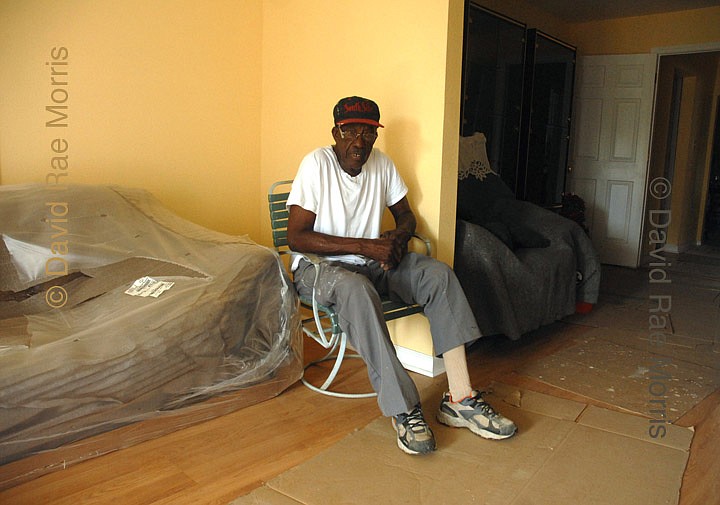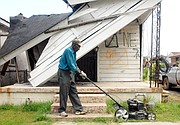Herbert Gettridge, then 83, sits in the front room of his house on North Roman Street in the Lower 9th Ward of New Orleans, Louisiana June 1, 2007, the first day of the Atlantic hurricane season. Gettridge evacuated New Orleans prior to Hurricane Katrina, but his house, which he built himself in the early 1950s, took on more than 10 feet of water. Photo courtesy David Rae Morris
Tuesday, December 23, 2014
I met him first in late January 2006. It was a sunny day that betrayed the magnitude of misery that had befallen the city. I was serving as an assistant and guide for the noted photojournalist David Burnett, who was on assignment for National Geographic. While access to the Lower 9th Ward was no longer restricted, there was virtually no one there, especially on the lakeside of Claiborne Avenue.
On this particular morning, we were just driving around. David spied an elderly African American man adding a wheelbarrow full of muck to a growing mountain of debris in front of his house on North Roman. Dressed in a white, long-sleeved shirt and khaki pants, a beat-up pair of sneakers and a baseball hat, he spoke with that specific inflection that meant he could only have been born and raised in New Orleans.
Herbert Gettridge died on Halloween Day at age 91. I had not seen him for a year or two, in part because it still pains me to drive over the bridge to the Lower 9th knowing how much suffering and destruction occurred there. But in the months following Katrina, I was there often, photographing, documenting the destruction and the misery.
My work with Burnett had allowed for a respite; at least I could focus on helping someone else with his work and not have to worry so much about my own. David was working with an old Speed Graphic, a 4 x 5 press camera popular in the 1930s and 1940s, and he made a remarkable portrait of Mr. Gettridge in what was left of his kitchen that ran in National Geographic on the first anniversary of Hurricane Katrina's landfall.
Before he left town to return to Washington, he had told me: "You really ought to check up on Herb every now and then." I knew he was right, but I was still overwhelmed by the magnitude of the storm and how it had affected New Orleans. I was working every day photographing for one newspaper or magazine or another, and there were plenty of other stories to cover.
But eventually I did go by to see Mr. Gettridge. He was always busy working around the house, tending to the yard; sometime we'd just sit on the porch and talk. I liked to call him Mr. G. He was born and raised in the 7th Ward. In 1934, when he was 11, he quit school and began apprenticing with his next-door neighbor, a master plasterer. It became his life-long trade, but he was handy with many tools. He had built his house with his own hands over a three-year period from 1949 to 1952.
"I started saving materials to build this house with, such as cement blocks, sills, bags of sand, cement," he said.
He stored the material at his uncle's house and then hired a truck to carry it down to his lot. "I poured the footin,' I laid the blocks, I did this all my self. ... Then I put the sills down, put the subfloors in, and I started framing."
He and his wife raised eight children in the house. They had evacuated to a downtown motel during Katrina. After they heard reports on the radio about the water rising in the Lower 9th, they left town and made it to his granddaughter's house in Shreveport. Then they went to Dallas, to Houston, back to Dallas, and eventually ended up at his daughter's house in Madison, Wis., where they stayed for a while.
Then one night Mr. Gettridge saw his house in a news report and realized it was still standing. He was immediately determined to get back. "I'm gone," he said to his wife, Lynda. "I'm leaving you right there."
He flew back to Louisiana. When they wouldn't let him into the neighborhood, he snuck in. The house had not moved off its foundation, and had not lost a single tile on the roof. But the water had risen almost to the ceiling. All their belongings were ruined, and the house needed to completely gutted.
When they opened the neighborhood, he came straight back and started working, commuting back and forth every day from Baton Rouge. Sometimes he'd sleep in his truck.
"When I got the first two rooms cleaned out, I said, 'This is it. No more Baton Rouge,'" he said. "Been here ever since."
The neighborhood was in ruin, and his was the only house on the block that would not eventually be torn down. Still, the task at hand seemed insurmountable.
"Got me a wheelbarrow, a rake, and a shovel and started diggin' my way in," he remembered. Even as the pile of debris in front of his house grew and grew—a cruel mix of building materials and the remnants of his life—he remained forever an optimist.
"A lot of people say, 'Why you want to go back down there in that slop and mud,'" he said. "I say it's not sloppy when the sun is shining."
He became a media darling, attracting the attention of Billy Crystal and Anderson Cooper, and other passing journalists and news crews. With the help of several relief organizations, he was able to rebuilt the house. All this time, his goal was to finish so he could bring his wife back.
"The flood is over with now,' he said. "We have to forget about the flood and get back to trying to live again."
Mr. G. lived in the house for a year without electricity or potable water. Slowly it began to take shape again. There were new walls, new floors, a new kitchen and bathroom, and finally the utilities were turned back on in March 2007. Lynda Gettridge returned from Wisconsin in that summer to great fanfare.
"I'm happy as hell to be right here," he told me in 2008. "This is where I want to be. I've lived in New York, Chicago, Detroit, Ohio." He was in the Merchant Marines, and later traveled extensively applying his trade as a plasterer. "Three, four weeks at a time, some of these places two and three years at a time, but I just don't see no place no better than New Orleans," he said. "I don't see no place where I'd like to stay."
Herbert Gettridge lived a full life. He did more in his 80s than most of us do in our entire lives. I know I am a better person for having known him.
While I am sad to learn of his passing, it comforts me to know that he died at home, in the house that he built with so much love and determination 60 years ago. May it continue to stand as a monument to his courage and perseverance. I am confident that it will survive the next flood.


Comments
Use the comment form below to begin a discussion about this content.
Sign in to comment
Or login with:
OpenID